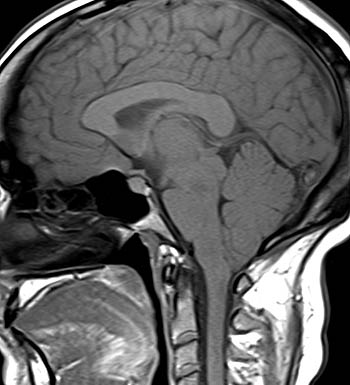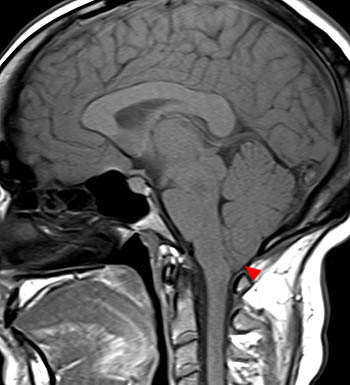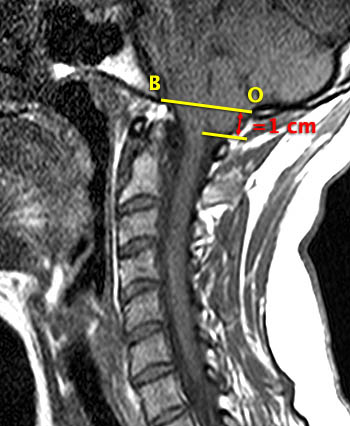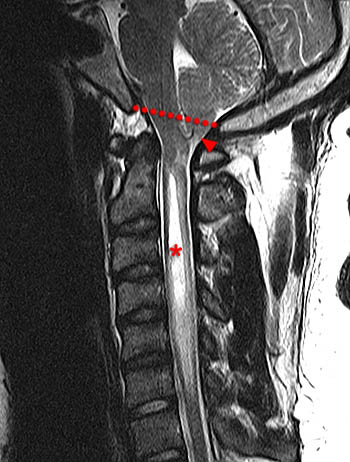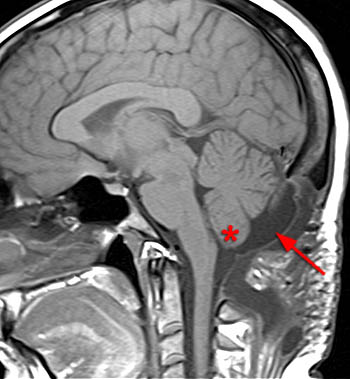Clinical history: A 36 year-old female presents with neck pain and headaches. A sagittal T1-weighted image of the brain is provided (1a). What is the finding? What is your diagnosis?
Diagnosis
Chiari I malformation.
Introduction
Chiari I malformation is the mildest form of a series of congenital hindbrain malformations, in which the cerebellar tonsils are displaced below the level of the foramen magnum.1, 2, 3 The prevalence in the general population is 0.1% with a slight female predominance.4 Supratentorial mass effect or cerebral hypotension can also cause herniation of the cerebellar tonsils2, 5; this phenomenon is referred to as an “acquired Chiari I malformation”.2
In 25% of cases, an associated congenital osseous abnormality of the skull base and/or cervical spine is present, including Klippel-Feil syndrome, basilar invagination, platybasia, atlanto-occipital assimilation, incomplete formation of the ring of C1, and short clivus. Sprengel deformity can also be seen.1, 2, 6, 5
Clinical presentation
The majority of patients with Chiari I malformation are asymptomatic. If symptomatic, patients usually present in adulthood.2, 3, 5, 7 Symptoms are most likely due to compression of the cerebellum, brainstem, or upper cervical spinal cord, and/or disruption of normal CSF flow dynamics.1 There is a wide spectrum of clinical presentations, ranging from vague symptoms related to the posterior fossa (headache, neck pain) to long tract signs that can mimic demyelinating disease.1, 2, 3 Patients can also present with episodic symptoms after coughing or sneezing, believed to be due to a transient increase in intrathecal pressure.1, 5
Criteria for diagnosis
Numerous studies have been performed to determine the degree of cerebellar tonsillar ectopia necessary for diagnosis of Chiari I malformation.7 An early study by Aboulezz et al. found that the position of the cerebellar tonsils on MRI in normal subjects was up to 2.8 mm below the level of the foramen magnum, while that of Chiari I patients was between 5.2 to 17.7 mm below the foramen magnum.8 In a larger series, Barkovich et al. found that the cerebellar tonsils extended up to 5 mm below the foramen magnum in normal patients, as compared to 3 to 29 mm in Chiari I patients.9 Milhorat et al. studied 364 symptomatic patients; the cerebellar tonsils were at least 5 mm below the foramen magnum in all but 9%. However, all of these patients showed compression of CSF spaces at the foramen magnum.10
The largest study of this type to date was performed by Meadows et al. in 2000, reviewing the MRI studies of over 22,000 patients. The authors found that 0.77% of patients had cerebellar tonsillar ectopia of at least 5 mm, and of those patients, 14% were asymptomatic.5, 11
Currently, the most commonly used criteria for diagnosis of Chiari I malformation is cerebellar tonsillar ectopia of at least 5 mm below the level of the foramen magnum.6, 12 A variant based on a study by Mikulis et al. recognizes changing cerebellar tonsillar position with age, with cutoffs of 6 mm up to age 10 years, 5 mm in ages 10 to 30 years, and 4 mm in ages 30 years and older.13 However, all authors agree that cerebellar tonsillar ectopia should not serve as the sole indication for surgical treatment in the absence of clinical signs or symptoms.5, 11
Diagnostic imaging
MRI is the definitive imaging study for diagnosis of Chiari I malformation. The position of the cerebellar tonsils is measured on sagittal T1- or T2-weighted images of the cervical spine or brain by drawing a line at the foramen magnum from the inner margin of the ophisthion to the basion, and then measuring the distance from that line to the inferior most margin of the cerebellar tonsils.6 Associated findings may include peglike or pointed tonsils, which can be seen in symptomatic or asymptomatic patients8, 9, or a “kink” at the cervicomedullary junction, which is seen in 71% of symptomatic patients3, 14. CSF spaces at the foramen magnum are often compressed. Of note, the greater the degree of displacement of the cerebellar tonsils below the foramen magnum, the higher the likelihood that the patient will be symptomatic.2, 12
Figure 3:
The position of the cerebellar tonsils is measured on this sagittal T1 weighted image of the cervical spine by drawing a line from the ophisthion (O) to the basion (B), and then measuring the distance from that line to the inferior most margin of the cerebellar tonsils. This patient has cerebellar tonsillar ectopia of 1 cm, consistent with Chiari I malformation.
In patients who have cerebellar tonsillar ectopia with equivocal clinical presentation, a dynamic MRI cine CSF flow study can provide additional information that can help identify those patients who may respond to surgical treatment. Positive findings include pulsatile systolic tonsillar descent, and obstruction of CSF flow at the level of the foramen magnum.7, 5, 15
Note should be made of a more recently described variant of Chiari I malformation, in which the cerebellar tonsillar ectopia is so severe that the brainstem is displaced caudally, causing the obex (the inferior margin of the fourth ventricle) to lie below the level of the foramen magnum. This variant is referred to as a “Chiari 1.5 malformation”.16, 17
Figure 4:
A sagittal T2-weighted image of the cervical spine in a 53 year-old female with neck pain and bilateral arm numbness reveals cerebellar tonsillar ectopia of 1.0 cm. A cervicomedullary kink is present (arrowhead), and a peglike appearance of the tonsils is noted. The lower border of the pons lies at the level of the foramen magnum (arrow), indicating that the medulla lies beneath the foramen magnum. This case meets the criteria for a Chiari 1.5 malformation.
Complications
The most common complication of Chiari I malformation is syringomyelia, an abnormal collection of CSF within the spinal cord which occurs in 20-40% of all patients, and 60% of symptomatic patients. The cervical spinal cord is the most common location, followed by combined cervical and thoracic syringomyelia. The syringomyelia may have a non-contiguous or “beaded” appearance. Isolated thoracic syringomyelia in association with Chiari I is uncommon.2, 12, 18 A less common complication is hydrocephalus, occurring in approximately 10% of patients.6 Both conditions occur due to disrupted CSF flow dynamics.
Figure 5:
A sagittal T2-weighted image of the cervical spine in a 23 year-old male complaining of neck pain and left arm pain and numbness. The cerebellar tonsils extend 7 mm below the level of the foramen magnum (arrow), consistent with Chiari I malformation. Abnormal fluid signal intensity within the spinal cord (asterisk) extends from C2 to C7, consistent with associated syringomyelia.
Treatment
The goal of treatment for symptomatic Chiari I malformation is to restore normal CSF flow dynamics at the foramen magnum. Treatment consists of suboccipital and/or high cervical surgical decompression. In the majority of patients, surgical decompression is very effective, with relief of symptoms in 90% and resolution of syringomyelia in 80%. Additionally, in children, arrest of progression of scoliosis can be seen.5, 19 Patients with a Chiari 1.5 malformation have a less consistent response to surgical treatment, with a higher incidence of persistent syringomyelia.16
Figure 6:
Follow-up examination of the initial patient presented, who is now status post suboccipital and high cervical decompression. Note resolution of both cerebellar tonsillar crowding and the peglike appearance of the tonsils (asterisk). A fluid collection posterior to the surgical site is consistent with a pseudomeningocele (arrow), a postoperative complication seen in some cases after decompression.
Conclusion
The Chiari I malformation is a not uncommon abnormality that may be encountered in MR imaging of the brain or cervical spine. By evaluating cerebellar tonsillar position and morphology, MRI is able to accurately diagnose patients with Chiari I. Associated syrinxes are also well visualized with MRI. Following surgery, MRI provides assessment of the new anatomy at the skull base, and allows identification of possible complications.
- Pakzaban, P. Chiari Malformation. Medscape (emedicine.medscape.com) 2014. ↩
- Osborn A. Diagnostic Neuroradiology (Mosby 1994), 17-18. ↩
- Latchaw RE. MRI and CT Imaging of the Head, Neck and Spine (Mosby 1991), vol 2, 756-757. ↩
- Speer MC, Enterline DS, Mehltretter L, Hammock P, Joseph J, Dickerson M, et al. Chiari type I malformation with or without syringomyelia: prevalence and genetics. J Genet Couns. 2003;12:297-311. ↩
- Osborn A et al. Diagnostic Imaging: Brain (Amirysys 2007), pages 9-10. ↩
- Knipe H, Gaillard F. Chiari I malformation. Radiopaedia.org. ↩
- Bejjanie GK, Definition of the Adult Chiari Malformation: A Brief Historical Overview. Medscape, Neurosurg Focus (emedicine.medscape,com) 2001; 11(1). ↩
- Aboulezz AO, Sartor K, Geyer CA, et al: Position of cerebellar tonsils in the normal population and in patients with Chiari malformation: a quantitative approach to MR imaging. J Comput Assist Tomogr 9:1033-1036, 1985. ↩
- Barkovich AJ, Wippold JF, Sherman JL, et al: Significance of cerebellar tonsillar position on MR. AJNR 7:795-799, 1986. ↩
- Milhorat TH, Chou MW, Trinidad EM, et al. Chiari I malformation redefined: clinical and radiographic findings for 364 symptomatic patients. Neurosurgery 44:1005-1017, 1999. ↩
- Meadows J, Kraut M, Guarnieri M, et al. Asymptomatic Chiari Type I malformations identified on magnetic resonance imaging. J Neurosurg 92:920-926, 2000. ↩
- Elster Ad, Chen MYM. Chiari I malformations; clinical and radiologic reappraisal. Radiology 183:347-353, 1992. ↩
- Mikulis DJ, Diaz O, Egglin TK, et al. Variance of the position of the cerebellar tonsils with age: preliminary report. Radiology 183:725-728, 1992. ↩
- Spinos E, Laster DW, Moody DW, et al: MR evaluation of Chiari I malformations at 0.15T. AJNR 6:203-208, 1985. ↩
- Hofkes SK, Iskandar BJ, Turski PA, Gentry LR, McCue JB, Haughton VM. Differentiation between symptomatic Chiari I malformation and asymptomatic tonsilar ectopia by using cerebrospinal fluid flow imaging: initial estimate of imaging accuracy. Radiology 245(2):532-40, Nov 2007. ↩
- Tubbs RS, Iskandar BJ, Bartolucci AA, Oakes WJ. A critical analysis of the Chiari 1.5 malformation. J Neurosurg (Pediatrics 2) 101: 179-183, 2004. ↩
- Kim I, Wang K, Kim I, Cho, B. Chiari 1.5 Malformation: An Advanced Form of Chiari I Malformation. J Korean Neurosurg Soc 48(4): 375-379, 2010. ↩
- Tubbs RS, Iskandar BJ, Bartolucci AA, Oakes WJ. A critical analysis of the Chiari 1.5 malformation. J Neurosurg (Pediatrics 2) 101: 179-183, 2004. ↩

